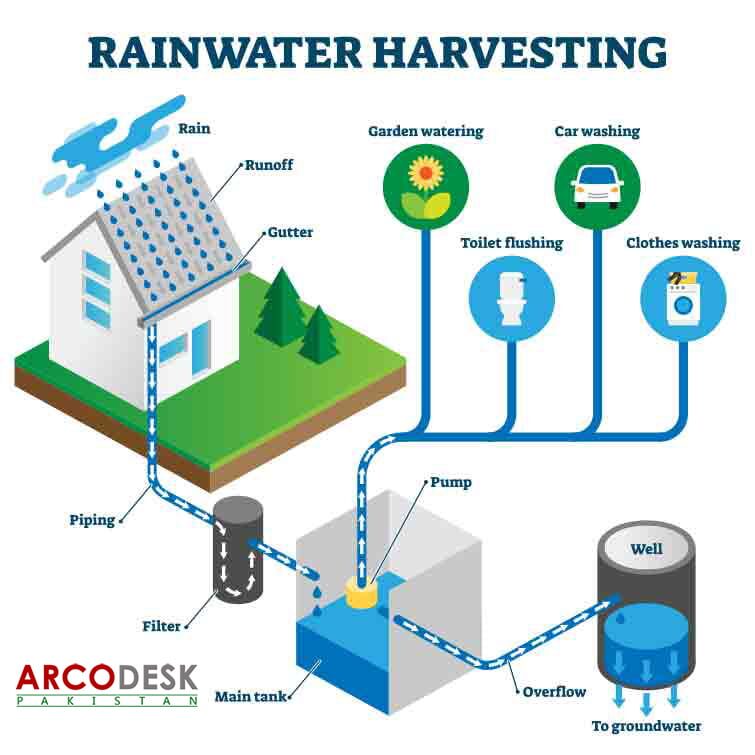Introduction to Rainwater Harvesting in Pakistan
Pakistan faces severe water scarcity. Over 80% of the population struggles with water stress in 2025. Rainwater harvesting offers a simple solution. It captures rain for household use. Small homes benefit most from low-cost systems. First, understand local climate challenges.
Why Rainwater Harvesting Matters
Monsoon rains hit Pakistan hard each year. Yet, droughts follow quickly. Harvesting saves water for dry seasons. It reduces reliance on groundwater. Moreover, it cuts utility bills by 50%. Families in Lahore and Karachi already see benefits. However, proper methods ensure success.
Basic Rooftop Collection System
Start with rooftops. They catch rain easily. Install gutters to channel water. Use PVC pipes for flow. Next, add a first-flush diverter. This removes debris from initial rain. Store water in plastic tanks. Capacity ranges from 500 to 2000 liters. Costs stay under PKR 10,000 for small setups.

Ground-Level Catchment Methods
Ground catchments work well in rural areas. Dig shallow ponds lined with plastic sheets. This prevents seepage. Then, cover with nets to block leaves. Pump water for home use. In Punjab, farmers harvest 70% of rainfall this way. It suits small plots under 500 square feet.
Low-Cost DIY Filtration Techniques
Filtration keeps water clean. Use sand and charcoal layers in barrels. First, pour rain through gravel. Next, sand traps particles. Charcoal removes odors. Finally, boil for drinking. This method costs PKR 5,000. It adapts to Pakistan’s dusty climate.
Underground Storage Solutions
Underground tanks save space in small homes. Dig pits and line with concrete. Capacity holds 10,000 liters. Cover with lids for safety. In Sindh, this method reduces evaporation by 60%. It fits urban areas like Islamabad. Costs range from PKR 15,000 to 25,000.

Community and Government Support
Government schemes boost adoption. Punjab’s program aids 50% of costs. Communities build shared systems. This cuts individual expenses. Moreover, NGOs train locals on maintenance. Success stories show 40% water savings.
Challenges and Solutions
Contamination risks exist in polluted areas. Use mosquito nets on tanks. Maintenance is key. Clean gutters monthly. Climate change worsens scarcity. Harvesting builds resilience. Start small to test methods.
Conclusion: A Sustainable Path Forward
Rainwater harvesting empowers small homes. It combats scarcity effectively. Adopt these methods today. Pakistan’s future depends on such steps. Act now for a water-secure tomorrow.
FAQ on Rainwater Harvesting Methods in Pakistan
What is Rainwater Harvesting?
Rainwater harvesting collects and stores rainwater for later use. It reduces reliance on groundwater. In Pakistan, it combats water scarcity affecting 80% of the population. This method suits arid regions like Balochistan.
Why is Rainwater Harvesting Important in Pakistan?
Pakistan faces severe water shortages. Annual rainfall averages 240 mm. Harvesting prevents floods and droughts. It supports agriculture, which uses 90% of water. Urban areas like Karachi benefit from reduced bills.
What are Common Rainwater Harvesting Methods in Pakistan?
Rooftop harvesting works best for small homes. Gutters channel rain to tanks. Ground catchment suits rural Punjab. Ponds store water for irrigation. Underground tanks save space in cities.
How Does Rooftop Harvesting Work?
Install gutters on roofs. Connect to storage tanks. Use filters to clean water. In Lahore, this method harvests 50,000 liters yearly per home. It costs PKR 10,000-20,000.
What is Ground Catchment Harvesting?
Dig shallow ponds lined with plastic. Collect surface runoff. Farmers in Sindh use this for crops. It captures 70% of rainfall. Maintenance prevents contamination.
Are There Underground Methods?
Build concrete tanks below ground. They store large volumes safely. In Khyber Pakhtunkhwa, this avoids evaporation. Costs range from PKR 50,000-100,000.
What Challenges Exist in Pakistan?
Contamination from dust affects quality. High initial costs deter adoption. Urban areas lack space. Climate variability reduces reliability. Maintenance is key.
What Government Support is Available?
Punjab’s program subsidizes 50% of costs. Sindh promotes community systems. National policies encourage harvesting in water-stressed areas.
How Much Does It Cost?
Basic rooftop systems cost PKR 5,000-15,000. Larger setups reach PKR 50,000. ROI comes from savings on bills.
Can Rainwater Harvesting Solve Water Scarcity?
It helps but needs widespread adoption. Combined with conservation, it eases shortages. Start small for big impacts.



